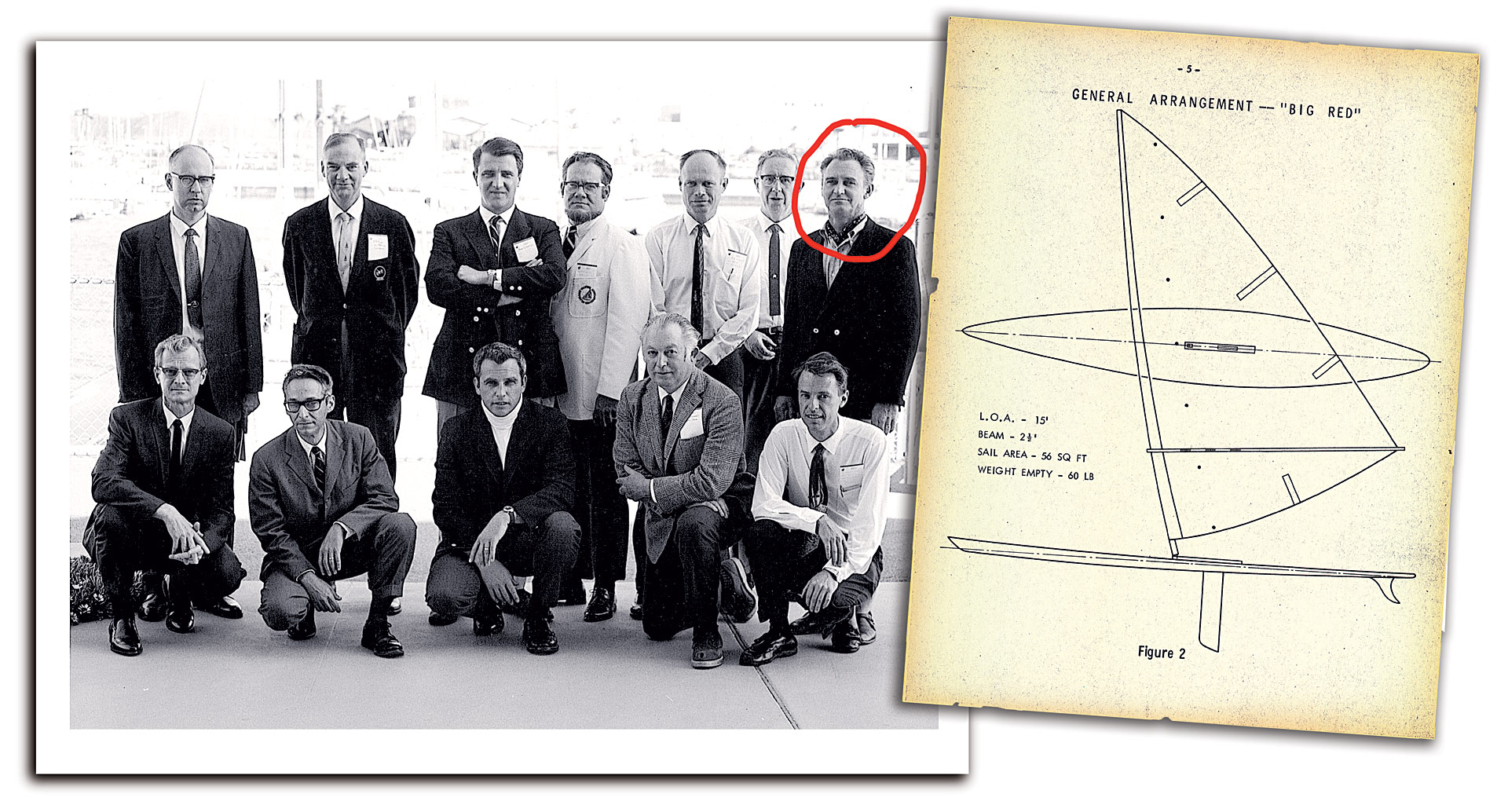Jim Drake standing and circled, presented the first paper on windsurfing at a symposium held on April 26, 1969 organized by Jack Stephenson kneeling below Drake. The event was held at the Marina Del Rey California Yacht Club. Almost thirty years later, the paper and Stephenson walked into the offices of American Windsurfer in New Hampshire.
THE AUTHENTICITY of the original manuscript was not hard to establish. A little research and a quick call to Jim Drake in his office in L.A. confirmed that what we had was not only authentic, but perhaps the only loose original manuscript in existence. Drake recounted the first AIAA (American Institute of Aeronautics and Astronautics) lecture entitled “The Ancient Interface Symposium on the Aeronautics/Hydronautics of Sailing” like it happened yesterday. He described how the RAND Corporation had given him time to compile the paper where he not only authored the words, but created the illustrations and drawings as well. We both marveled at the coincidence and the level of probability that the paper would travel thirty years and end up in the same town that American Windsurfer is published. Jim Drake remembered Jack Stephenson and without hesitation, he agreed to an interview a few weeks later.

WINDSURFING: A NEW CONCEPT IN SAILING
by James R. Drake,
The RAND Corporation
1700 Main Street, Santa Monica,
California 9040
Introduction
In ancient times and up to the point where steam propulsion became dominant, speed under sail had entirely practical consequences. Commercial shipping costs usually reduced as speeds increased, and in naval ships, speed added to strategic and tactical mobility. However, in recent times where sails are used almost exclusively on pleasure craft, the need for speed under sail is entirely subjective. That is, the speed of a boat is judged to be high or low, not explicit in economy or military terms but rather in the mind of the skipper— usually with reference to another boat of similar characteristics. Contemporary sailboats are actually quite slow compared to the faster of their forerunners. Put another way, the pleasure of sailing comes from a sensation of creating speed rather than the actual speed itself.
Advertisement
This thought is not particularly new, and it certainly has not diminished the pleasure and, as a consequence, popularity of sailing. Other factors have a far greater dampening influence on the sport of sailing. Principal among these are: (1) the high cost of owning and operating a boat and (2) the inconvenience of handling, maintaining, storing, launching, and landing. It would seem desirable, therefore, if a sailboat could be devised which would have the cost and handling characteristics of snow skis and surfboards and still retain or improve the features which are primarily responsible for the great popularity of sailing, namely, high(subjective) speed and close individual participation.
A new concept in sailing—called windsurfing— has been developed (and patented) which satisfies these requirements to a far greater degree than any currently available sailing craft. The purpose of this paper is to introduce this new concept and to explain some of the technical factors which led to its successful development. This new concept grew out of conversations beginning in 1961 with Fred A. Payne Jr., Vice President of Technical Operations, Martin Marietta Corporation, Orlando. Successful development has been possible through the help of Hoyle Schweitzer of Legal Billing Systems, Inc. and Alan Parducci, Professor of Psychology, UCLA. David T. Griggs, Professor of Geophysics, UCLA, and Professor Parducci have been a great help in preparing this manuscript.
The Concept
A few years back the desire for a “sporty” and “speedy” sailboat which could be bought, stored and operated with a minimum of inconvenience and cost led to the development of the sailboard. There are perhaps 50 or so variations, the most popular of which is the Sailfish/Sunfish series produced by Alcourt, Inc. of Waterbury, Connecticut. The Sailfish weighs about 120 lbs., is about 13-1/2 feet long, has a little less than a 3 foot beam and carries up to 75 sq. ft. of sail on an equilateral lateen rig. The boat is controlled by a conventional tiller with the mainsheet brought forward to midships where the crew (normally one) either sits or lays. The Sunfish is somewhat larger. Both boats owe their success to the sensation they create of great speed in spite of several features known to be less than optimum for high speed designs. The hull’s sharp chines and the low aspect ratio lateen sail are the principal objections from an aero-dynamic point of view. Nor are these craft or their many imitations a great deal easier to handle and store than other cat-rigged from the Sabot (slow but handy) to the Finn (fast but unwieldy). The Sailfish/Sunfish is , however, the best attempt so far to combine the features of speed and convenience and is the standard against which ant improvements must be judged.
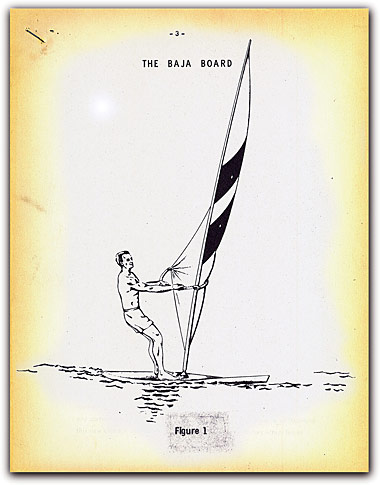
Windsurfing differs from all other forms of sailing in that the boat—named the “Baja Board”—is ridden in a standing position and is controlled and steered by a handheld sail assembly. (Fig. 1). The mast is stepped onto the board through a fully articulated universal joint but is otherwise unsupported. The board is always level and need not be designed for other than zero angle of heel. The sail is held taught between twin booms joined at the mast about 4-1/2 feet above the deck. The rider grasps the sail/mast/boom assembly by the windward boom. The sail is trimmed to the apparent wind by pivoting the sail assembly around a vertical axis. The sail’s center of effort is adjusted to the center of the hull’s resistance forces by “dipping” the sail assembly fore and aft. Thus the sail’s driving and turning forces are sensed and controlled directly by the rider of the board. There is no rudder and none is needed. The fact that the rider is standing—not sitting— allows him to quickly adjust the sail position and c.g. location to changing wind and sea conditions. In this position, he also stands well above the waves and spray, that normally attend a small sporty sailing craft. The handheld articulated sail assembly prevents the board from being capsized by high winds and provides a natural dead man control when the rider takes his inevitable swim. In the open ocean the board surfs easily on swells and even on short wind driven chop. A different sailing skill is required, more akin to surfing and skiing—boredom is completely eliminated—and once wind-surfing is mastered, it gives a unique and heady blend of sporting thrills.
The Design
Six different designs for the Baja-Board have been built and tested to date. For clarity , however, only one of these will be described in this section. Advantages and disadvantages of the other five will be discussed in a later section. The design described here (Fig. 2)—named Big Red because of its large size and its red striped sail— is the fastest of the six and has been used as a trial horse against which to judge improvements in speed and handling.
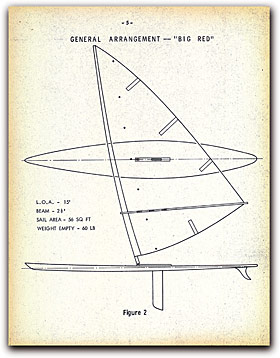
Big Red is 15 ft. long, 2-1/2 ft. wide and draws 3 inches with hull alone or 2-1/2 feet with the center board extended. A sail of 56 sq. ft. is carried on a 14 foot mast. The entire unit weighs about 70 lbs. and can be carried with two hands, one for board, the other for the sail assembly in its storage bag. Though it has not yet entered formal competition, Big Red has easily outraced both Sailfish and Sunfish.
The double-ended board has fine lines fore and aft. The 1-1/2 sq. ft. center board is located six inches aft of the center of buoyancy; the mast is stepped six inches forward of the center of buoyancy. A detachable skeg is mounted near the stern to give the needed amount of directional stability. The board is constructed of 3 lb./cu. ft. foam with two red wood longitudinal stiffeners and covered with one to two layers of fiberglass. The construction technique is similar to that used is the manufacture of contemporary surfboards. The weight of the board alone is about 50 lbs.
Advertisement
The mast is hollow and tapers from about two inches O.D. at the base to one inch O.D. at the tip. It is constructed of fiberglass with a technique similar to that used for vaulting poles. The twin booms (often called a “wishbone” boom)are made of laminated fir or pine shaped so as not to interfere with the sail’s longitudinal curve. They are joined to the mast with heavy nylon tape to prevent stress concentration on the fiberglass mast. A heavy-duty, stainless steel universal joint, attached to the base of the mast, permits 360o mast rotation around a vertical axis and 180o around orthogonal horizontal axes. The base of the universal joint is attached to a wooden plug that fits a longitudinal slot in the board. The sail is cut from 4 oz. dacron sailcloth and attached to the mast with a nylon sock. Battens are used to obtain a fair degree of roach on the sail’s leach and foot. When the outhaul is released the sail assembly folds together and is stored in a bag 14 ft. long, 1-1/2 ft. wide. The weight of the sail in its bag is 20 lbs.
An understanding of how the articulated sail assembly is able to control the direction of the board can be gained by considering relation between the principal forces that act on the board/sail combination (Fig. 3). These forces are the heeling and driving forces of the wind on the sail. (FH and FD respectively) and the lateral and longitudinal resistance of hull/centerboard/skeg combination (RL and RD respectively). Sails of the proper chamber have their center of effort near the geometric area mean; the center of hull resistance can be approximated by the geometric are mean of the skeg/centerboard combination. When these forces and their moments are balanced in the horizontal plane there is zero turning moment and the board will continue forward in a straight line. Turning the board may be accomplished then by purposely upsetting this balance. The most efficient way to do this is to move FH with respect to RL since these are normally the strongest forces. This may be done by “dipping” the mast forward or aft depending on the desired change of direction. Dipping the mast forward moves FH forward with respect to RL producing a downwind turning moment and the board will fall off; dipping the mast aft moves FH aft with respect to RL producing an upwind turning moment and the board will come up into the wind.
Actually, its a good deal more complicated than merely adjusting FH with respect to RL. These and the other forces all pass through the rider in the form of twisting, pulling and pushing with arms and legs. It is not always possible to isolate FH and RL from FD and RD since he must also maintain his balance, adjust his position and keep the sail trimmed at the same time. He also needs to maintain some margin of stability to account for unexpected upsetting forces such as wind gusts and waves. With practice, though, these forces may all be brought into balance and the rider will utilize FH and RL as the primary means of control.
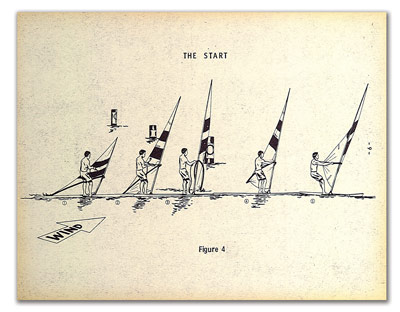
Operation
To start, the sail is taken from its bag and rigged tightly securing the clew with the outhaul, much like stringing a bow. The downhaul may also be adjusted. Next, the board is launched and the sail assembly is attached by dropping the wooden plug into the mating hole in the board. At this point the sail assembly is floating flat on the surface of the water. The rider then mounts the board and stands straddling the universal joint (fig. 4). He grasps a lanyard which is attached to the mast/boom junction. A steady pull on this lanyard brings the sail out of the water into an erect position. The sail will weather-cock and the rider takes a position upwind of the mast. The rider then grasps the twin booms , with one hand on either side of the mast. The board is then rotated (twisted underfoot) to the desired direction using sail force for leverage. When the board is properly aligned the rider moves to one side of the mast and changes his grip on the sail assembly to what will become the windward boom. The mast is then dipped to windward, the sail is trimmed (by pulling on the downwind arm) and the board is under way. Once moving as mentioned above, the direction of the board is controlled by changing the dip angle of the mast. To come up into the wind, the mast is dipped off; to fall of the wind, the mast is dipped forward.
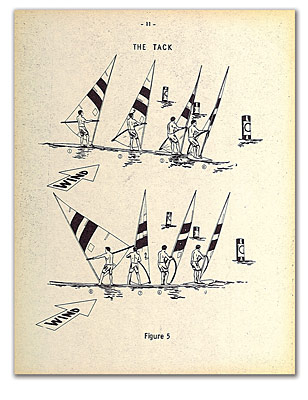
The tack is initiated by dipping the mast aft (Fig. 5). As the board comes up into the wind the sail is continually trimmed to provide a maximum of side forces. In this way the board will continue through the eye of the wind and the rider will find himself walking around forward of the mast step. At a certain point, when the board is headed in the proper new direction with respect to the wind, the rider steps fully around the mast and repositions his grip to the opposite boom. The new tack is begun by dipping the mast forward again and trimming the sail in the opposite direction.
The jibe is begun by dipping the mast forward, facing the board to fall off to a running position (fig.6). As this is done the rider walks slightly aft and to the center of the board until, when the board is running fully before the wind the rider is standing amidships facing forward. From this position the rider moves his grip around the mast to the opposite boom. This causes the sail first to weathercock and then fill on its opposite side to complete the jibe. Note that unlike conventional boats the sail itself never needs to jibe no matter what change of direction is called for.
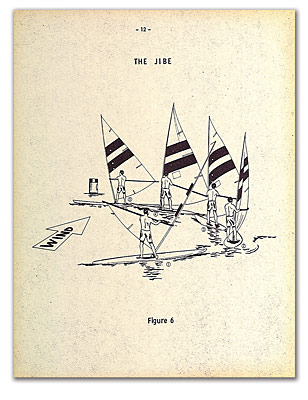
A useful maneuver—called a power jibe—has been developed to change quickly from one tack to another under circumstances (close confines, rough water, etc.) where a regular tack is not advisable. This maneuver (Fig. 7) may be executed from any point of sailing by rotating the sail away from its trimmed position forcing it to be back-winded. This is done by moving the grip toward the mast and reaching around the front of the mast with one hand to grasp and pull the opposite boom. The back-winded sail quickly stops the board’s forward progress and turns the bow of the board down and through the wind to the opposite tack.
It may be obvious at this point that windsurfing requires the development of certain unique skills. The learning period varies with the individual, of course, but a qualitative assessment of the difficulty of the sport indicates it to be a fair amount more difficult to learn than waterskiing or day sailing, but a bit easier then surfing and snow-skiing. (It could be that there are still many useful maneuvers of greater difficulty which are as yet undiscovered.) As one would expect, sheltered waters with light winds are the best conditions to learn the fundamental maneuvers described above. Practicing these moves improves balance and board control so that eventually the rider can concentrate his attention on sail trim to get the most out of a given wind. When balance and control are mastered the rider may attempt wind-surfing in stronger winds and less sheltered areas—including the open ocean. As one might imagine, the greatest thrills are to be gained under the more difficult conditions—up to a point, of course.
Alternate Board Designs
It was mentioned earlier that six different board designs have been built and tested with varying degrees of success. All have used the same 56 sq. ft. sail configuration. These six designs, shown on Fig. 8, are as follows:
“Old Yeller,” so named because it was the first Baja-Board ever built and carried a yellow sail, is a slightly enlarged tandem surfboard 11-1/2 ft. long, 2-1/2 feet wide and 4-1/2 in. thick. In plan view its nose and tail are quite blunt. Side on, its nose is thin with some longitudinal spoon while its tail was kept flat. The center board and universal joint mast step were one assembly located close to the center of buoyancy.
“Big Red,” described in preceding sections was the second board built, 15 ft. long, 2-1/2 ft. wide and 4-1/2 in. thick of double-ended design, along the lines of an international sailing canoe. The high aspect ratio center board, located aft of the center of buoyancy was separate from the mast step assembly so that it might be raised in shallow water.
“New Skate,” of which three units have been built, is a compromise design between Old Yeller and Big Red, 13-1/2 ft. long, 2-3/4 ft. wide and 4-1/2 in. thick. It has a full nose and a transom stern. A medium aspect centerboard ratio is separate from the mast step assembly.
“The Door,” is an attempt to develop a board which could be cheaply constructed in one’s garage overnight. It is built from two 4’ x 8’ sheets of plywood separated by 1” x 3” longitudinal and lateral members glued and nailed together. A piece of foam is glued to the nose, shaped to relieve the otherwise bluff blow and covered with fiberglass. Total construction time :3 hours.
“The Sled,” is designed to promote planing without compromise toward any other point of sailing. Like other boards it is fiberglass covered foam, 11′ long, 3’ wide tapering from 6” deep at the transom to 1” thick at the nose. The nose is curved upward like a water-ski, but is otherwise dead flat on the bottom. Multiple skegs are substituted for the center board.
“Yellow Submarine,” was named because of its habit of sounding like a harpooned whale whenever the wind blew very strong. Like the Door it is constructed of two 4’ x 8’ sheets of plywood. These were split lengthwise, placed end-for-end and separated by 1” x 3” strips of wood. The bow and stern taper to 1 foot width, and there is a slight upturn of the bow. This is the only design that does not require a skeg.
The fastest of these six designs on almost all points of sailing is Big Red. This could be expected because of its great length and high aspect-ratio center board. Big Red is challenged, at times, by New Skate when beating. This was not expected. The low aspect-ratio center board, the full lines of the nose and the flat lines aft on the New Skate were intended to improve its speed off the wind, not on the wind. Most of the trials, however, were run in the open sea where the influence of waves could well dominate the more traditional factors thought to influence speed. As evidence of this, Yellow Submarine, for all of its simplicity, was nearly as fast as New Skate. This was astonishing since its habit of sounding (or pearling) mentioned above sent great sheets of water aft along the deck of the board that impinged on the base of the mast and the legs of the rider. Leg drag and mast drag are factors not normally carried in hydrodynamic computations. Yellow Submarine, however, evidenced neither pounding nor hobby-horsing. This was because the nose cut through the small waves rather than rising over them. Old Yeller is just a trifle slower than Big Red and New Skate no doubt because of its short length. This slight reduction in speed in many ways is compensated by the handiness of the short board. The Sled had flashes of really great speed when surfing in front of ocean swells on a broad reach; otherwise it seemed tied to the dock. The door never got a call. The static and low-speed lateral stability of the board is of interest during the learning process and when the board is used in chop and ground swells. All six designs had their specific peculiarities. The Door and the Sled are by far the most stable and have been of great help in early instruction. Big Red is a good deal less stable because of its narrower beam. What stability it does have is mainly the result of the deep center board; when the center board is raised it is a bit spooky. Old Yeller and New Skate are both about as stable as Big Red (centerboard down) since they have greater average width but shallower center boards. This latter fact makes the stability of these two designs less effected by the rising of the center board. Yellow Submarine is the narrowest and consequently gives the greatest trouble.
All designs exhibited improved stability and control once under way in sheltered waters. The more critical test, however, is in the open ocean under high winds coupled with chops and swell. Under these conditions the Door and the Sled are again the most manageable. Old Yeller and New Skate are satisfactory but both have the tendency to either pound or pearl depending on whether the rider is standing fore or aft. Big Red, however, has quite different characteristics. Its fine lines and great length prevent both pound and pearling but the deep section of its bow makes it sensitive to side-slap of chop approaching from the forward quarter. This makes Big Red wander about more than somewhat, requiring continuous compensation from the rider in the form of body balance, mast dip and sail trim. This could be the reason why Big Red is not as fast on a beat. Big Red has another objectionable feature in that it is not roll restoring, (A board is said to be roll restoring if, while under way, it tends to turn into the direction of roll, not away.) and therefore has a strong tendency to broach when the seas are on its aft quarter. Yellow submarine seems always on the ragged edge of controllability.
As a general rule all boards becomes less controllable as the wind rises and the waves increase. This is because of the increased size and frequency of upsetting forces (waves) coupled with the increased forces on the sail. This problem is unavoidable but can be alleviated somewhat by replacing the aft skeg with one of greater size. This increases the directional stability of the board and reduces the board’s sensitivity to changes in lateral forces. It also moves the center of lateral effort aft, forcing the sail and rider aft to a position of greater board stability. However, increasing the size of the aft skeg means that the board will not turn as quickly. For this reason there is a size of skeg which is best suited to each wind and wave condition as well as to the skill of the rider.
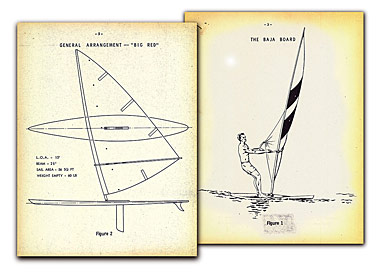
The limited testing that has been accomplished to date has not been conducted in as rigorous or systematic a manner as might be desired and there is as yet no experience in closed course racing. Most of the time has been spent perfecting the mechanical feature and having fun. Some conclusions, however, can be drawn with respect to the design of a good all-around board which would be fast in both flat and choppy water and which has good stability under adverse conditions of wind and wave. Tentatively these conclusions are:
1. Overall length should be as long as possible, limited only by handling convenience. 14 ft. or more is good and coincides approximately with the length of the mast with which the board must be stored.
2. Width should be as narrow as possible, and still provide enough static lateral stability for the rider to stand and raise the sail from the water. A deep center board helps this somewhat but has the adverse effect of limiting shallow water operation unless a means for raising and lowering is provided. In any event a width of 2 feet or less seems right.
3. The depth of the board should be about 5 to 6 inches in the center, tapering to less than an inch fore and aft, so as to provide adequate buoyancy for a 160 to 180 lb. rider. All dimensions scale about as the fourth root of the weight of the rider.
4. The rails should be carried roughly parallel fore and aft for a good percentage of the board to reduce the tendency to broach.
5. The nose should be sharp edged to reduce the effects of wave side–slap.
6. Chines should be soft at the mid section to reduce wetted area and local form drag losses.
7. The aft butt planes (vertical sections parallel to the board’s centerline) should be flat and the tail should be sharp edged to promote planing.
8. The construction of the board should be as lightweight as possible: 2 to 3 lb./cu. ft. foam; two thin longitudinal stiffeners; two thin layers of fiberglass where the rider stands, one layer everywhere else.
9. Both the aft skeg and the center board should be detachable for storage convenience and to allow all adjustment of size for differing wind, wave and water depth conditions.
10. The mast should be stepped one to two feet forward of the center of lateral effort and about 1/2 foot forward of the center of gravity. The added complication of a movable mast location may also be worth the trouble.
A board having these general characteristics will likely be built and tested during the coming year. In the meantime, however, a series of somewhat shorter but wider boards are being constructed using an existing mold. These boards will be a little simpler to learn, a little easier to handle, and a little less expensive. And for all we know now, they could be the fastest yet—or ever.
Alternate Sail Configurations
As mentioned earlier all Baja-Boards to date have carried the same 56 sq. ft. sail. This was selected because of the existence of a lightweight 14 ft. hollow tapered fiberglass mast. It has permitted direct comparison of differing board designs but has yielded little information regarding sail design. Some qualitative factors have been determined, however, which lead to the judgement that the present configuration is not terribly wrong.
The twin boom configuration coupled with the flexible mast permits the sail to set well over its entire height. The chamber seems good for all points of sailing but the closest beat, and even then not at all bad.
The 56 sq. ft. sail is about all that a strong man can handle in 12 to 15 knot winds. It is also a little large for the beginner. For this reason, reefing points (parallel to the luff) are advisable. In light winds, up to 7 knots, an increase of sail area to the vicinity of 100 sq. ft. may be desirable for the expert but this has not yet been tried.
More efficient sail designs like higher aspect ratios, full battens, etc. could increase the sail’s driving forces. Most of these techniques, however, tend to raise the sail’s center of effort (which is now about head height) causing proportionately greater strain on the rider for the same driving force. Since the combined effect of sail force and moment is inherently limited by the strength of the rider, it is not yet clear whether smaller efficient sails or larger inefficient sails yield the greater net driving force.
All in all, there is as yet no powerful reason to change from the present configuration.
Conclusion
Perhaps it is now clear that wind-surfing represents a unique departure in the sport of sailing. The hand-held fully articulated sail is an entirely new means of propulsion and control. It has been made possible only through the relatively recent development of lightweight high strength materials which do not deteriorate in the presence of water. It has been further helped by the perfecting of certain manufacturing processes—notably fiberglass covered foam filled surfboards and dacron sails. Beyond this, however, there was a recognition of the great desirability for compact , easily handled equipment which with some level of skill, would create the excitement of high speed sailing for the rider—and incidentally the buyer.
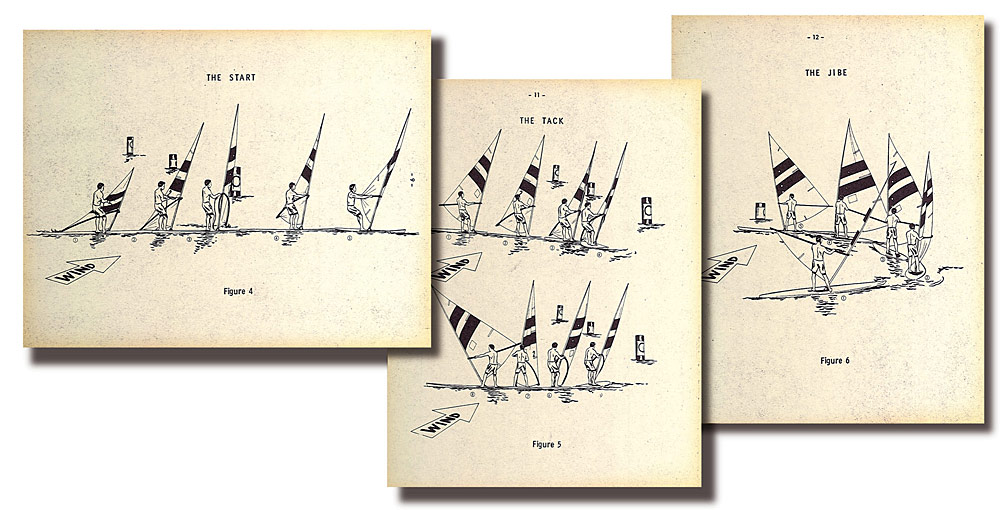
Have something to add to this story? Share it in the comments.


